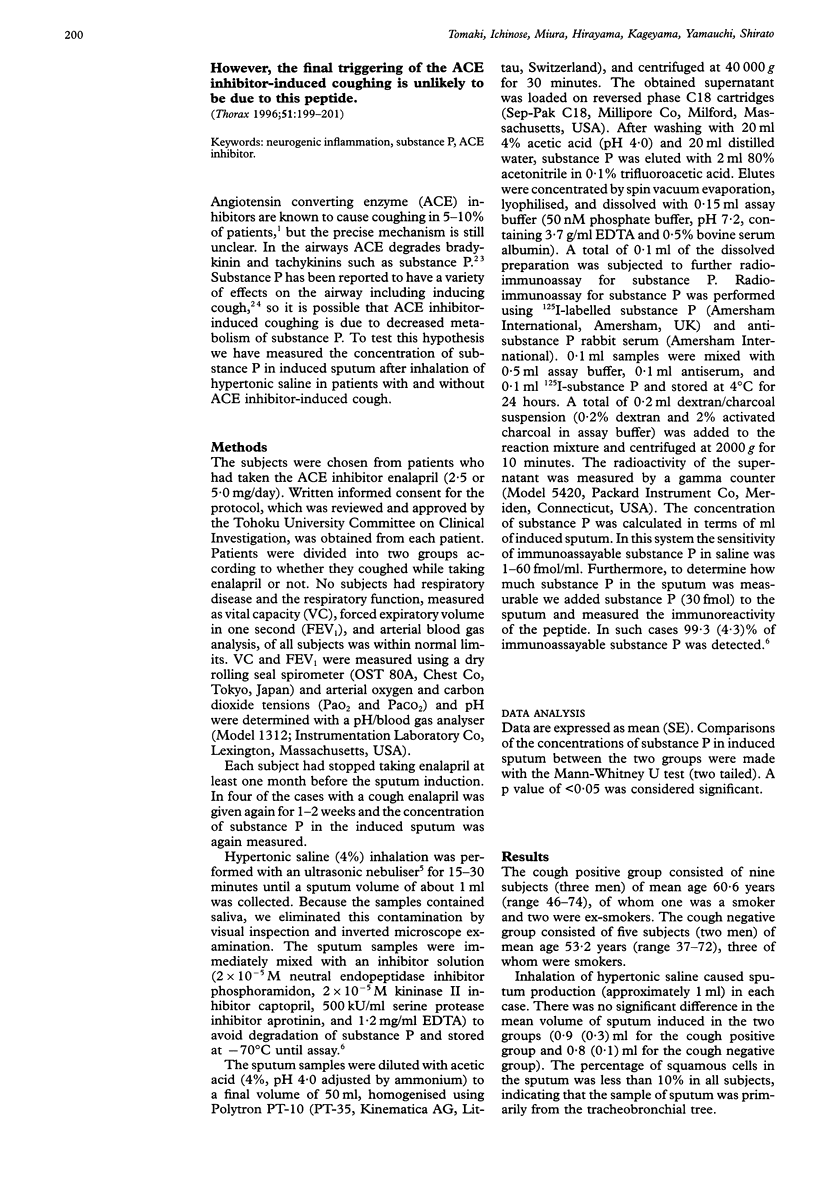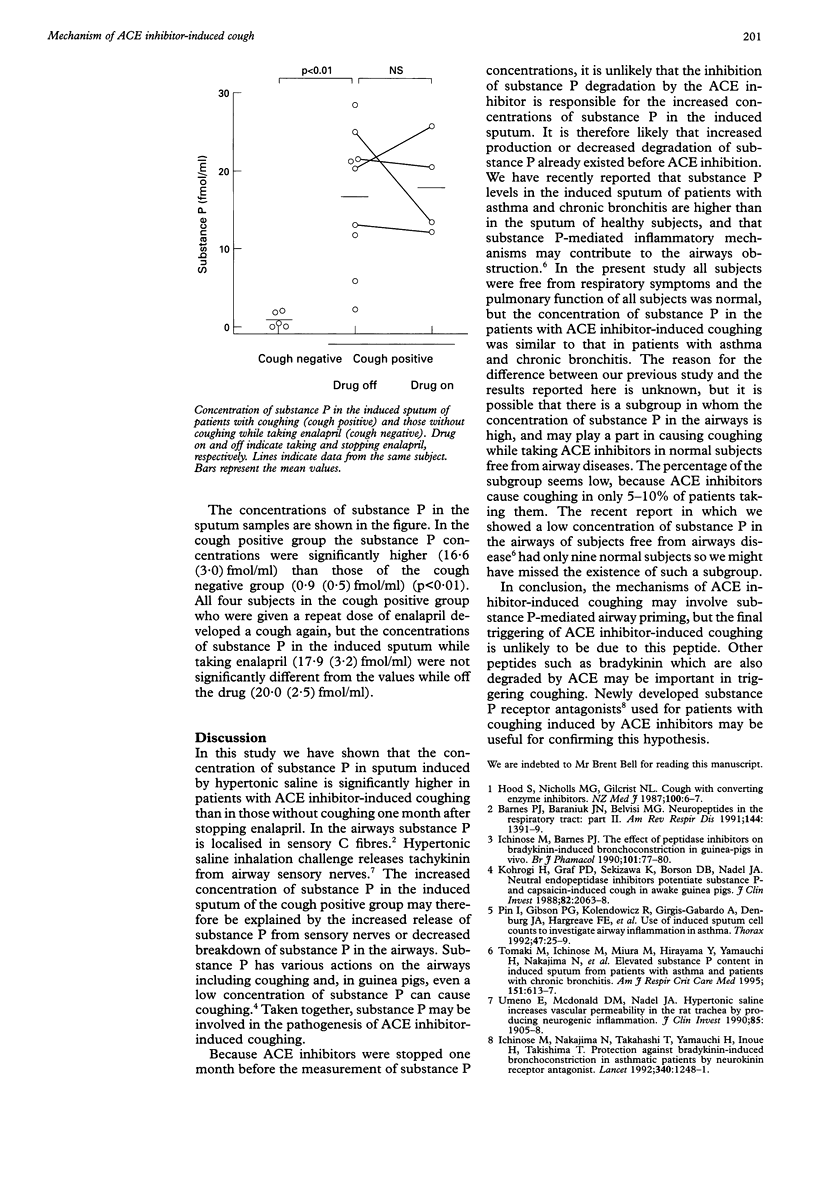Abstract
BACKGROUND: Angiotensin converting enzyme (ACE) inhibitors cause coughing in 5-10% of patients, but the exact mechanisms of this effect are still unclear. In the airways ACE degrades substance P so the cough mechanism may be related to this peptide. METHODS: Nine patients who developed a cough and five patients who did not develop a cough when taking the ACE inhibitor enalapril (2.5 or 5.0 mg/day) for hypertension were enrolled in the study. No subjects had respiratory disease and the respiratory function of all subjects was normal. One month after stopping enalapril, inhalation of hypertonic saline (4%) was performed using an ultrasonic nebuliser for 15-30 minutes to induce sputum. The concentration of substance P in the sputum sample was measured by radioimmunoassay. In four of the nine cases with a cough enalapril was given again for 1-2 weeks and the concentration of substance P in the induced sputum was again measured. RESULTS: One month after stopping enalapril the mean (SE) concentration of substance P in the sputum of the group with a cough was 16.6 (3.0) fmol/ml, significantly higher than that in the subjects without a cough (0.9 (0.5) fmol/ml). All four subjects in the group with a cough who were given a repeat dose of enalapril developed a cough again, but the concentrations of substance P in the induced sputum while taking enalapril (17.9 (3.2) fmol/ml) were similar to the values whilst off enalapril (20.0 (2.5) fmol/ml). CONCLUSIONS: The mechanisms of ACE inhibitor-induced coughing may involve substance P mediated airway priming. However, the final triggering of the ACE inhibitor-induced coughing is unlikely to be due to this peptide.
Full text
PDF


Selected References
These references are in PubMed. This may not be the complete list of references from this article.
- Barnes P. J., Baraniuk J. N., Belvisi M. G. Neuropeptides in the respiratory tract. Part II. Am Rev Respir Dis. 1991 Dec;144(6):1391–1399. doi: 10.1164/ajrccm/144.6.1391. [DOI] [PubMed] [Google Scholar]
- Ichinose M., Barnes P. J. The effect of peptidase inhibitors on bradykinin-induced bronchoconstriction in guinea-pigs in vivo. Br J Pharmacol. 1990 Sep;101(1):77–80. doi: 10.1111/j.1476-5381.1990.tb12092.x. [DOI] [PMC free article] [PubMed] [Google Scholar]
- Ichinose M., Nakajima N., Takahashi T., Yamauchi H., Inoue H., Takishima T. Protection against bradykinin-induced bronchoconstriction in asthmatic patients by neurokinin receptor antagonist. Lancet. 1992 Nov 21;340(8830):1248–1251. doi: 10.1016/0140-6736(92)92948-f. [DOI] [PubMed] [Google Scholar]
- Kohrogi H., Graf P. D., Sekizawa K., Borson D. B., Nadel J. A. Neutral endopeptidase inhibitors potentiate substance P- and capsaicin-induced cough in awake guinea pigs. J Clin Invest. 1988 Dec;82(6):2063–2068. doi: 10.1172/JCI113827. [DOI] [PMC free article] [PubMed] [Google Scholar]
- Pin I., Gibson P. G., Kolendowicz R., Girgis-Gabardo A., Denburg J. A., Hargreave F. E., Dolovich J. Use of induced sputum cell counts to investigate airway inflammation in asthma. Thorax. 1992 Jan;47(1):25–29. doi: 10.1136/thx.47.1.25. [DOI] [PMC free article] [PubMed] [Google Scholar]
- Tomaki M., Ichinose M., Miura M., Hirayama Y., Yamauchi H., Nakajima N., Shirato K. Elevated substance P content in induced sputum from patients with asthma and patients with chronic bronchitis. Am J Respir Crit Care Med. 1995 Mar;151(3 Pt 1):613–617. doi: 10.1164/ajrccm.151.3.7533601. [DOI] [PubMed] [Google Scholar]
- Umeno E., McDonald D. M., Nadel J. A. Hypertonic saline increases vascular permeability in the rat trachea by producing neurogenic inflammation. J Clin Invest. 1990 Jun;85(6):1905–1908. doi: 10.1172/JCI114652. [DOI] [PMC free article] [PubMed] [Google Scholar]


